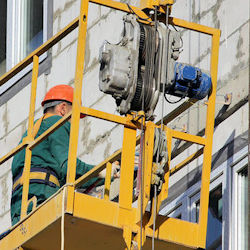Adjustable-Suspension Scaffolds
Add a hoist to move the platform up or down, and you have an adjustable-suspension scaffold - but not necessarily a safe one.
Suspension ropes, lifelines, platforms, hoists, overhead support devices, and tieback systems are critical to the safety of adjustable-suspension scaffolds.
Before you use an adjustable-suspension scaffold, you need to know how to:
- rig the scaffold,
- operate the hoist,
- work safely from the scaffold, and
- what to do in an emergency.
Other requirements include the following:
- A competent person must examine all direct connections that are part of the system and confirm that the connections will support the platform loads.
- You must also wear a personal fall-arrest system to protect yourself if a connection fails.
Most accidents involving adjustable-suspension scaffolds happen when a primary suspension rope breaks and workers are not wearing personal fall-arrest gear. Steel suspension ropes rarely break if they're correctly rigged, maintained, and inspected regularly. If you work on an adjustable-suspension scaffold more than 10 feet above a lower level, you must be protected from falling.
Causes of Falls
- ascending platforms snag and electric hoists continue to operate snapping weak ropes;
- pressure from the two steel discs that clamp support ropes in sheave-type hoist motors can break a weak rope;
- failing anchors also cause serious accidents;
- workers don't use personal fall-arrest systems as required;
- untrained workers attach lifelines and suspension ropes to unapproved rooftop fixtures; and
- lifelines fail because they are hung over unpadded edges.
Types of Fall Protection
- Single-point and two-point adjustable-suspension scaffolds: Personal fall-arrest systems and guardrail systems are required on single-point or two-point adjustable-suspension scaffolds. The top edge of the guardrail must be between 36 inches and 45 inches above the platform surface. (The top edge can exceed 45 inches when necessary.)
- Multipoint adjustable-suspension scaffolds: Personal fall-arrest systems and guardrail systems are required on multipoint adjustable-suspension scaffolds. The top edge of the guardrail must be between 36 inches and 45 inches above the platform surface. (The top edge can exceed 45 inches, when necessary.)
Knowledge Check Choose the best answer for the question.
4-8. When working on an adjustable-suspension scaffold, at what height must you be protected from falling?
You forgot to answer the question!

